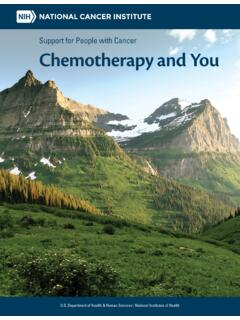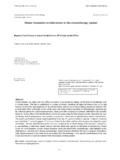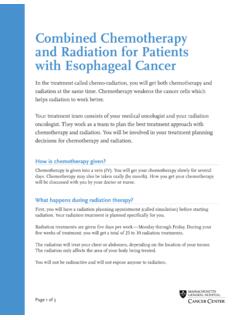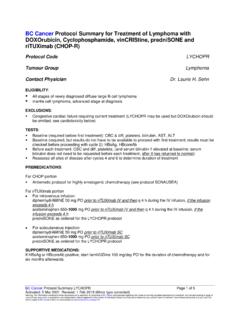Transcription of Guidelines for Prevention and Treatment of Chemotherapy ...
1 BC Cancer Guidelines for Prevention and Treatment of Chemotherapy -Induced Nausea and Vomiting in Adults Protocol Code SCNAUSEA Tumour group SUPPORTIVE CARE Physician Contact Dr. Paul Hoskins ELIGIBILITY Adults receiving Chemotherapy . Drug acquisition: Antiemetics are considered supportive Treatment . These agents are not BC Cancer benefit drugs and are not covered by any BC Cancer program. Patients being treated with these agents should have prescriptions filled at a community pharmacy and must arrange their own payment for the drugs. EXCLUSION CRITERIA Pediatric patients. Radiation-induced nausea and vomiting. APPROACH TO Treatment The goal is NO nausea or It is far easier to prevent nausea and vomiting than to treat ,2 Anticipatory nausea and vomiting is a conditioned response, and can only happen after a negative past ,2 Ensure optimal antiemetic therapy for every cycle of Chemotherapy .
2 Use of Guidelines : This is a general reference based upon best available evidence and is not intended to replace the clinical judgment of individual practitioners caring for individual patients. BC Cancer Protocol Summary SCNAUSEA Page 1 of 7 Activated: 4 May 1999 Revised: 1 July 2020 (Footnotes to prophylaxis table) Warning: The information contained in these documents are a statement of consensus of BC Cancer professionals regarding their views of currently accepted approaches to Treatment . Any clinician seeking to apply or consult these documents is expected to use independent medical judgement in the context of individual clinical circumstances to determine any patient's care or Treatment . Use of these documents is at your own risk and is subject to BC Cancer's terms of use available at PROPHYLACTIC ANTIEMETIC REGIMENS FOR IV AND COMBINED IV / ORAL Chemotherapy For multiple days of Chemotherapy , repeat antiemetics before each Treatment (Exception: netupitant-palonosetron is dosed on day 1 only).
3 See comment below table for ORAL Chemotherapy regimens. For prophylaxis after prior Treatment failures, refer to Figure 1. EMETOGENICITY PRE- Chemotherapy POST- Chemotherapy dexamethasone 8 to 12 mg PO1-3 dexamethasone 4 mg PO evening of chemo,3 then BID x 2 to 4 days2,3 PLUS NK1 and 5-HT3 ANTAGONIST netupitant-palonosetron 300 mg PO18 No post- Chemotherapy netupitant-palonosetron High (HEC)* OR OR aprepitant 125 mg PO7-9 PLUS one 5-HT3 antagonist : aprepitant# 80 mg PO daily on days 2 and 3, IF aprepitant used on day 12,8,9 o ondansetron 8 mg PO3 o granisetron 1 mg PO17,19 o palonosetron mg PO17,19 +/- ONE ANTIEMETIC AS-NEEDED (if not using olanzapine): prochlorperazine 10 mg PO every 6 hours PRN x 3 to 4 days3,18 OR metoclopramide 10 to 20 mg PO every 4 to 6 hours PRN x 3 to 4 days3,4,18,19 +/- olanzapine 5 to 10 mg PO15,18 +/- olanzapine 5 to 10 mg PO daily on days 2, 3 and 4 (if olanzapine used on day 115,18.)
4 Do not use with prochlorperazine or metoclopramide) dexamethasone 8 to 12 mg PO3,18 dexamethasone 4 mg PO evening of chemo,3 then PO BID x 2 to 3 days2,3 Moderate (MEC)* PLUS ONE 5-HT3 ANTAGONIST: ondansetron 8 mg PO3 granisetron 1 mg PO17,19 palonosetron mg PO17,19 +/- ONE ANTIEMETIC AS-NEEDED : prochlorperazine 10 mg PO every 6 hours PRN x 3 to 4 days3,18 OR metoclopramide 10 to 20 mg PO every 4 to 6 hours PRN x 3 to 4 days3,4,18,19 +/- olanzapine 5 to 10 mg PO15,16,18 +/- olanzapine 5 to 10 mg PO daily on days 2 and 315,16,18 (if olanzapine used on day 115; do not use with prochlorperazine or metoclopramide) Low dexamethasone 4 to 12 mg PO1,2 OR prochlorperazine 10 mg PO18 OR metoclopramide 10 to 20 mg PO3,4,18 OR ondansetron 8 mg PO17-19 OR granisetron 1mg PO17-19 OR no prophylaxis19 dexamethasone 4 mg BID PRN for up to 2 to 3 days1-3 OR prochlorperazine 10 mg PO every 6 hours PRN x 3 to 4 days3,18 OR metoclopramide 10 to 20 mg PO every 4 to 6 hours PRN x 3 to 4 days3,4,18,19 OR no prophylaxis3,18,19 Minimal (Rare)
5 Prophylactic Treatment not normally required18,19 prochlorperazine 10 mg PO every 6 hours PRN x 3 to 4 days3,18 OR metoclopramide 10 to 20 mg PO every 4 to 6 hours PRN x 3 to 4 days3,4,18,19 OR no prophylaxis3,18,19 BC Cancer Protocol Summary SCNAUSEA Page 2 of 7 Activated: 4 May 1999 Revised: 1 July 2020 (Footnotes to prophylaxis table) Warning: The information contained in these documents are a statement of consensus of BC Cancer professionals regarding their views of currently accepted approaches to Treatment . Any clinician seeking to apply or consult these documents is expected to use independent medical judgement in the context of individual clinical circumstances to determine any patient's care or Treatment . Use of these documents is at your own risk and is subject to BC Cancer's terms of use available at Pre- Chemotherapy is interpreted as 30 to 60 minutes prior to the start of Chemotherapy *Highly emetogenic Chemotherapy (HEC), Moderately emetogenic Chemotherapy (MEC); MEC replaces high-moderate and low-moderate in previous versions Dexamethasone doses may be individualized.
6 When netupitant-palonosetron is used with anthracycline and cyclophosphamide (AC) based protocols, omission of day 2 to 4 dexamethasone doses is recommended. In general, lower dexamethasone doses and/or shorter durations may be considered for patients on non-CISplatin regimens. Steroids are not recommended as antiemetics for immunotherapies18,29 Netupitant-palonosetron 300 mg capsules are a fixed dose, combination product given on day 1 only. Aprepitant is the NK1 antagonist of choice for docetaxel containing regimens; pharmacokinetic studies demonstrate a 35% increase in docetaxel AUC when co-administered with Netupitant-palonosetron is likely safe to use in patients with soy/peanut allergies; however, a very low potential for allergic reaction does exist as trace amounts of soya lecithin may be For inpatients unable to swallow: Consider replacing pre- Chemotherapy aprepitant with fosaprepitant IV 150 mg Post- Chemotherapy fosaprepitant NOT needed,2,9,10 dose of 5-HT3 antagonist and dexamethasone remain the same (fosaprepitant 150 mg confers comparable serum level to aprepitant 125 mg11 which seems sufficient to cover days 2 and 312) No additional 5-HT3 antagonist is required if netupitant-palonosetron combination Note palonosetron has a long duration of action (t1/2 ~44 h in adults).
7 29 Consider adding olanzapine if nausea / vomiting not controlled with 5-HT3 antagonist plus dexamethasone plus NK1 antagonist in previous cycle, especially if delayed nausea is a concern. Note: olanzapine adverse drug reactions including sedation and QTc prolongation, drug interactions and black box warning of increased mortality in elderly patients with dementia. Olanzapine should NOT be used with metoclopramide, prochlorperazine, or haloperidol due to increased risk of extrapyramidal #For multiday Chemotherapy regimens: Limited data exist for netupitant-palonosetron. Efficacy has been shown with standard dosing of 1 capsule on day one of a three-day HEC Aprepitant is the NK1 antagonist of choice for 3 and 5 day regimens. Limited data support dosing oral aprepitant over extended Suggested regimens based on 5-day cisplatin regimens22,23: aprepitant 5-HT3 antagonist dexamethasone 125 mg PO day 1, then 80 mg PO days 2 to 722 days 1 to 522 days 1 to 822 125 mg PO day 3, then 80 mg PO days 4 to 723 days 1 to 523 days 1 and 223 Suggested regimens based on 3 day MEC and HEC regimens24 aprepitant 5-HT3 antagonist dexamethasone 125 mg PO day 1, then 80 mg PO days 2 to 5 ( , dose 2 additional days post Treatment ) On Treatment days days 1 to 5 ( , 2 additional days post) PROPHYLACTIC ANTIEMETIC REGIMENS FOR ORAL CHEMOTHERAPY18: High or moderate emetogenic risk.
8 Choose one 5-HT3 antagonist pre- Chemotherapy as listed for HEC/MEC in table above post Chemotherapy breakthrough dosing as listed for HEC/MEC in table above Low or minimal (rare) emetogenic risk: prn recommended if nausea/vomiting occurs: o metoclopramide 10 to 20 mg PO pre- Chemotherapy then q6h prn OR o prochlorperazine 10 mg PO pre- Chemotherapy then q6h prn (max 40 mg/day) OR o choose one 5-HT3 antagonist as listed in table above for low emetogenic risk, given daily prn post Chemotherapy breakthrough dosing as listed in table above for low/minimal (rare) emetogenic risk BC Cancer Protocol Summary SCNAUSEA Page 3 of 7 Activated: 4 May 1999 Revised: 1 July 2020 (Footnotes to prophylaxis table) Warning: The information contained in these documents are a statement of consensus of BC Cancer professionals regarding their views of currently accepted approaches to Treatment .
9 Any clinician seeking to apply or consult these documents is expected to use independent medical judgement in the context of individual clinical circumstances to determine any patient's care or Treatment . Use of these documents is at your own risk and is subject to BC Cancer's terms of use available at ADDITIONAL Treatment NOTES If IV administration of a 5-HT3 antagonist is clinically indicated, use the same IV dose as the oral dose for ondansetron and In contrast, palonosetron mg PO is equivalent to palonosetron mg IV17,19. Single doses of 5-HT3 antagonists are as effective as multiple ,5 First generation 5-HT3 antagonists (ondansetron, granisetron) are equally effective. Choose based on availability and ,5 Palonosetron, a second generation 5-HT3 antagonist, has a longer duration of action compared to first generation 5-HT3 First generation 5-HT3 antagonists may increase the risk of arrhythmia and Torsade de Pointes in patients: with congenital long QT syndrome, congestive heart failure, or bradyarrhythmias with pre-existing hypokalemia or hypomagnesemia, using medications that prolong QT interval or cardiotoxic Chemotherapy .
10 ECG monitoring is recommended in the above ,20 Except for highly emetogenic Chemotherapy , a corticosteroid alone is the cornerstone of therapy for Prevention of delayed nausea and vomiting. There is no role for the routine use of 5-HT3 antagonists more than 24 hours after ,6 Currently available NK1 antagonists are equally ,19 Olanzapine may be included on days 1 to 4 of HEC or on days 1 to 3 of MEC for additional control of delayed A lower dose of 5 mg should be considered for elderly and over-sedated patients. Other cautions include: o Increased risk of death in elderly patients with dementia related psychosis2 o Concomitant administration of parenteral olanzapine and parenteral benzodiazepine is not recommended (toxicity may occur regardless of route)18 o QTc prolongation (see above monitoring recommendations for 5-HT3 antagonists) o Sedation, most notable on day 2 o Fall risk o Extrapyramidal symptoms Olanzapine and single-agent palonosetron are not covered by DETERMINING EMETOGENICITY OF Chemotherapy Emetogenicity18: percentage of patients who will experience acute emesis if not treated.















